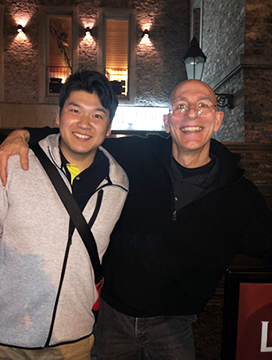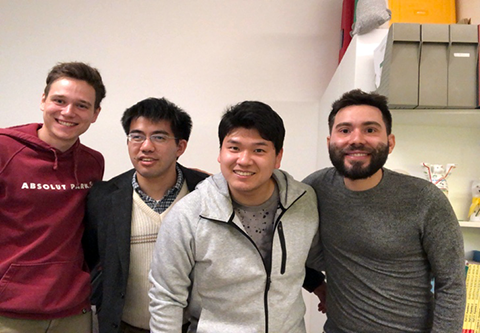国際・国内交流
清水 健太郎さん(第6学年次)
Würzburg大学留学を終えて
今回、2019年4月1日〜4月28日までの1ヶ月間の選択実習をWürzburg大学の麻酔科と核医学で行いましたことを報告させていただきます。このWürzburg大学はドイツ連邦共和国・バイエルン州に位置しており、正式名はJulius-Maximilians-Universität Würzburgです。今回は日本とドイツとの医療制度や臨床現場の違い、また個人的に感じた事について述べていきたいと思います。
ビュルツブルク大学は約600年の歴史を持ち、出島の医師として有名なシーボルトが卒業した大学であり、またX線を発見したレントゲン博士が教鞭を執っていた大学でもあります。そんな長い歴史をもつ大学で実習できたことは何よりもいい経験になりました。
まず前半の2週間は麻酔科の実習でした。麻酔科は朝の集合時間が毎日6時台と始まりが早く、まずは全体カンファレンスで情報交換をして整形外科、眼科、産科、ペインクリニック、精神科、外科などのそれぞれの科に麻酔科医が出向するという形を取っていました。今回僕が経験させていただいたのは精神科、眼科、整形外科でした。精神科で麻酔科が何をするの?という疑問が僕の中に湧き上がりましたが、これは日本とドイツとの治療の違いを教えられてわかりました。日本ではメジャーではないのですが、ドイツではうつ病などに対して電気通電療法なるものをよく行うらしいのです。この療法は読んで字のごとく電気を頭につけた電極から流すために、全身の筋肉も副作用的に収縮してかなりの筋肉の破壊を誘発してしまうため、短期的に筋弛緩薬を使って筋破壊を防ぎます。そのため麻酔科医が必要となるのです。ここで学んだバックバルブマスクの基本的手技は麻酔科医になるには必要不可欠の手技で、何度も反復して練習させていただきました。ここで感じたこと、学んだことは、ドイツ人は顔が大きく、とても片手では密閉状態を作り出せず、安定した換気ができなかったのですが、これは単に顔が大きいからとか、ドイツ人はみんな手が大きいからとかではなく、バックバルブの向きや力のかけ方、指の置き位置などによって完璧な換気が得られるということでした。
精神科以外にも、眼科や整形外科にも麻酔科実習として行きました。ここでは日本とは決定的に違う点がありました。それはInvasion roomがあるということでした。日本では手術室にて麻酔を施しますが、ドイツではこのInvasion roomにて麻酔を施すのです。しかし、ここに立ち入っていいのは麻酔科医とそれに従属する看護師だけです。その目的というのは決して外科医が急かすことができないようになっており、その時間的、精神的余裕により医療ミスを防ぐという点があります。このような部屋ができた背景には、ドイツの教育システムが根深く関係しており、この事についても少し言及したいと思います。
ドイツでは学生や研修医のような立場の先生を教える際は、上級医がマンツーマンで指導します。その際、見学メインではなくて、学生にも積極的に侵襲的手技を行わせます。そのため必然的に指導に時間がかかり、処置にも時間がかかります。仮に手術室で麻酔もしてしまうと、外科医は早くオペを始めたいとプレッシャーをかけてしまい、結果としてミスに繋がり、時として患者さんの生命を脅かしてしまう可能性もあります。その為に麻酔科医以外不可侵の領域を作り、教育と安全を双方担保するためにこのInvasion roomができたと言われています。そして例に漏れず、私もラインの確保や気管挿管、ラリンジアルマスク挿管を積極的にさせて頂き、貴重な経験となりました。
後半の2週間は核医学の実習を行いました。ドイツでは日本と違い放射線を使った治療がほぼ毎日行われており、核医学の治療という面では最先端に位置しています。バセドウ病の患者さんには放射線を放っているカプセルを飲ませたり、褐色細胞腫の患者さんには放射線を放っている薬液を点滴したりして治療していました。他にはエコーの手技やCT、MRIの読影のポイントなどをレクチャーして頂きました。残念ながら僕の実習期間ではなかったのですが、MRIの定期点検日には、その内部が見られるという滅多にない体験もできたそうでした。
僕は昔から海外にとても興味があり、学内の留学チャンスには積極的に申し込んでいました。しかし今回は1ヶ月という今までの留学プログラムよりは長く、ひとりでの実習なので不安が大きく、楽しみというより挑戦という気持ちの方が強かったと思います。しかし、この留学を終えた今、本当に行ってよかったと心の底から感じており、そして今後の自分の人生にとってもかけがえのない財産となりました。
この留学で熱心に指導してくださったDr.Gをはじめ、現地でのコンサルトしていただいたB、国際交流センターの鳥井さん、またこの留学に協力してくださった皆様方にこの場を借りて深く感謝申し上げます。ありがとうございました。

